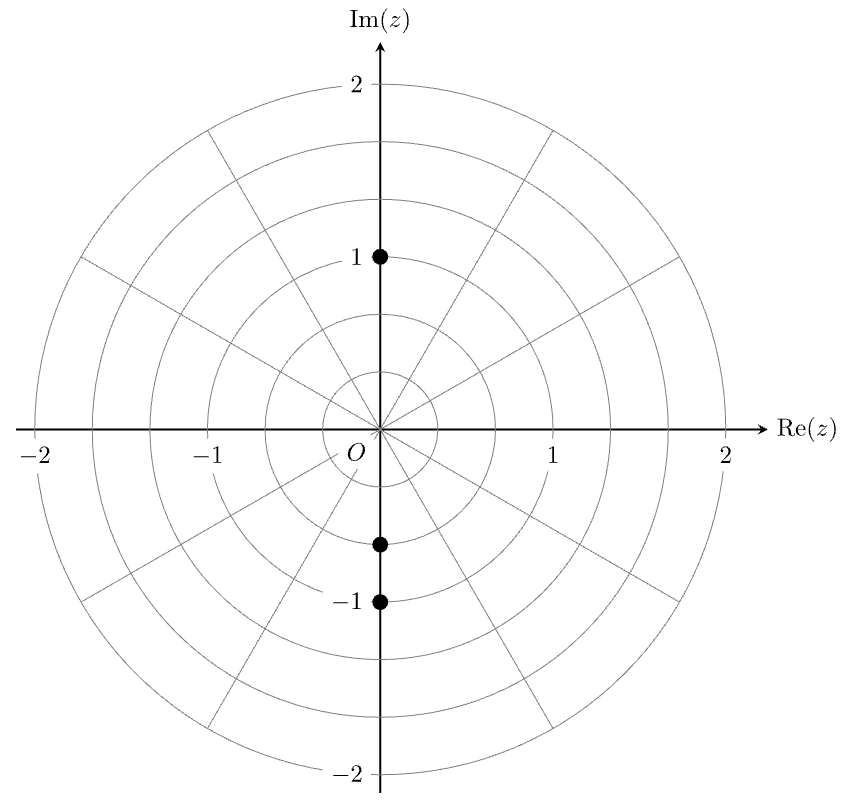Consider the function with rule \(f(z)=3 z^3+2 i z^2+3 z+2 i\), where \(z \in C\). --- 3 WORK AREA LINES (style=lined) --- --- 5 WORK AREA LINES (style=lined) --- --- 0 WORK AREA LINES (style=lined) ---
Complex Numbers, SPEC2 2023 VCAA 2
Let \(w=\text{cis}\left(\dfrac{2 \pi}{7}\right)\). --- 2 WORK AREA LINES (style=lined) --- --- 2 WORK AREA LINES (style=lined) --- --- 0 WORK AREA LINES (style=blank) --- --- 0 WORK AREA LINES (style=lined) --- --- 3 WORK AREA LINES (style=lined) --- --- 4 WORK AREA LINES (style=lined) --- --- 3 WORK AREA LINES (style=lined) --- use De Moivre's theorem to show that --- 8 WORK AREA LINES (style=lined) ---
Complex Numbers, SPEC2 2019 VCAA 2
- Show that the solutions of `2z^2 + 4z + 5 = 0`, where `z ∈ C`, are `z = −1 ± sqrt6/2 i`. (1 mark)
--- 3 WORK AREA LINES (style=lined) ---
- Plot the solutions of `2z^2 + 4z + 5 = 0` on the Argand diagram below. (1 mark)
--- 0 WORK AREA LINES (style=lined) ---
Let `|z + m| = n`, where `m, n ∈ R`, represent the circle of minimum radius that passes through the solutions of `2z^2 + 4z + 5 = 0`.
-
- Find `m` and `n`. (2 marks)
--- 3 WORK AREA LINES (style=lined) ---
- Find the cartesian equation of the circle `|z + m| = n`. (1 mark)
--- 2 WORK AREA LINES (style=lined) ---
- Sketch the circle on the Argand diagram in part a.ii. Intercepts with the coordinate axes do not need to be calculated or labelled. (1 mark)
--- 0 WORK AREA LINES (style=lined) ---
- Find `m` and `n`. (2 marks)
- Find all values of `d`, where `d ∈ R`, for which the solutions of `2z^2 + 4z + d = 0` satisfy the relation `|z + m| <= n`. (2 marks)
--- 4 WORK AREA LINES (style=lined) ---
- All complex solutions of `az^2 + bz + c = 0` have non-zero real and imaginary parts.
Let `|z + p| = q` represent the circle of minimum radius in the complex plane that passes through these solutions, where `a, b, c, p, q ∈ R`.
Find `p` and `q` in terms of `a, b` and `c`. (2 marks)
--- 4 WORK AREA LINES (style=lined) ---
Complex Numbers, SPEC2 2011 VCAA 8 MC
Complex Numbers, SPEC1 2012 VCAA 3
Consider the equation `z^3-z^2-2z-12 = 0, \ z in C.`
Complex Numbers, SPEC2 2017 VCAA 4
- Express `−2-2sqrt3 i` in polar form. (1 mark)
--- 3 WORK AREA LINES (style=lined) ---
- Show that the roots of `z^2 + 4z + 16 = 0` are `z = −2-sqrt3 i` and `z = −2 + 2sqrt3 i`. (1 mark)
--- 3 WORK AREA LINES (style=lined) ---
- Express the roots of `z^2 + 4z + 16 = 0` in terms of `2-2sqrt3 i`. (1 mark)
--- 2 WORK AREA LINES (style=lined) ---
- Show that the cartesian form of the relation `|z| = |z-(2-2sqrt3 i)|` is `x-sqrt3 y-4 = 0` (2 marks)
--- 5 WORK AREA LINES (style=lined) ---
- Sketch the line represented by `x-sqrt3y -4 = 0` and plot the roots of `z^2 + 4z + 16 = 0` on the Argand diagram below. (2 marks)
--- 0 WORK AREA LINES (style=lined) ---
- The equation of the line passing through the two roots of `z^2 + 4z + 16 = 0` can be expressed as `|z-a| = |z-b|`, where `a, b ∈ C`.
Find `b` in terms of `a`. (1 mark)
--- 3 WORK AREA LINES (style=lined) ---
- Find the area of the major segment bounded by the line passing through the roots of `z^2 + 4z + 16 = 0` and the major arc of the circle given by `|z| = 4`. (2 marks)
--- 5 WORK AREA LINES (style=lined) ---
Complex Numbers, SPEC2-NHT 2017 VCAA 2
One root of a quadratic equation with real coefficients is `sqrt 3 + i`.
-
- Write down the other root of the quadratic equation. (1 mark)
--- 2 WORK AREA LINES (style=lined) ---
- Hence determine the quadratic equation, writing it in the form `z^2 + bz + c = 0`. (2 marks)
--- 5 WORK AREA LINES (style=lined) ---
- Write down the other root of the quadratic equation. (1 mark)
- Plot and label the roots of `z^3-2 sqrt 3 z^2 + 4z = 0` on the Argand diagram below. (3 marks)
--- 0 WORK AREA LINES (style=lined) ---
- Find the equation of the line that is the perpendicular bisector of the line segment joining the origin and the point `sqrt 3 + i`. Express your answer in the form `y = mx + c`. (2 marks)
--- 5 WORK AREA LINES (style=lined) ---
- The three roots plotted in part b. lie on a circle.
Find the equation of this circle, expressing it in the form `|z-alpha| = beta`, where `alpha, beta in R`. (3 marks)
--- 5 WORK AREA LINES (style=lined) ---

